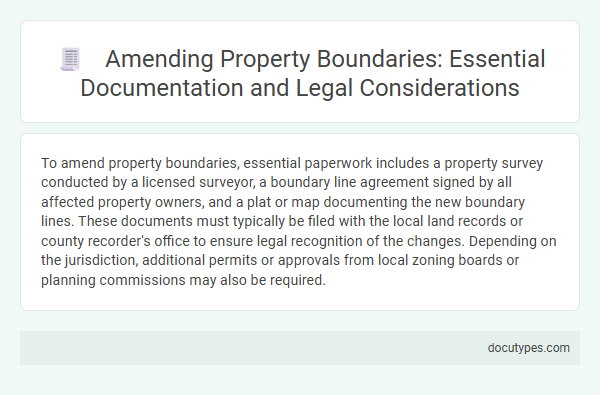To amend property boundaries, essential paperwork includes a property survey conducted by a licensed surveyor, a boundary line agreement signed by all affected property owners, and a plat or map documenting the new boundary lines. These documents must typically be filed with the local land records or county recorder's office to ensure legal recognition of the changes. Depending on the jurisdiction, additional permits or approvals from local zoning boards or planning commissions may also be required.
Introduction to Amending Property Boundaries
Amending property boundaries involves legal changes to the lines that define your land ownership. It requires specific paperwork to ensure the modification is officially recognized and recorded. Understanding the necessary documentation is crucial before starting the boundary adjustment process.
Key Reasons for Property Boundary Amendments
Amending property boundaries requires specific paperwork, including a formal boundary survey, a legal description of the new boundaries, and an application for a boundary adjustment or lot line change filed with the local land records office or planning department. Key reasons for property boundary amendments include resolving boundary disputes between neighbors, accommodating land development or construction projects, and correcting errors in original property descriptions. Proper documentation ensures legal recognition of the new boundaries and helps avoid future conflicts or title issues.
Understanding Legal Frameworks and Regulations
What paperwork is required to amend property boundaries? Amending property boundaries involves submitting a boundary adjustment application to the local land registry or planning authority. The process requires detailed property surveys, legal descriptions, and proof of ownership to ensure compliance with zoning laws and land use regulations.
Essential Documentation for Boundary Changes
Amending property boundaries requires specific legal paperwork to ensure the changes are officially recognized. Essential documentation includes a boundary survey, a plat map, and a signed agreement between affected property owners.
The boundary survey must be conducted by a licensed surveyor to accurately measure and mark new property lines. A plat map illustrates these changes and is submitted to the local government or county recorder's office. Additionally, a boundary line agreement signed by all involved parties resolves any disputes and confirms consent to the amendments.
The Role of Land Survey Reports
Amending property boundaries requires precise documentation to ensure legal accuracy and avoid disputes. Land survey reports play a crucial role in providing detailed measurements and official records needed for boundary changes.
- Land Survey Report - A professional surveyor creates this document to define exact property lines and identify any encroachments or discrepancies.
- Legal Description Update - The survey report forms the basis for updating the legal description in property deeds to reflect amended boundaries.
- Submission to Local Authorities - You must submit the land survey report and related paperwork to municipal or county offices for approval and official record changes.
Obtaining and Filing the Amended Title Deed
To amend property boundaries, obtaining an amended title deed is a crucial step. This document officially records the new property lines as agreed upon or determined through surveys and legal processes.
Filing the amended title deed requires submitting it to the local land registry or cadastral office. This ensures the changes are legally recognized and reflected in public records, protecting property rights and preventing disputes.
Consent and Notification Requirements
Amending property boundaries requires specific paperwork focusing on consent and notification to ensure legal compliance and avoid disputes. Proper documentation and communication with all affected parties are essential steps in the process.
- Owner Consent - All property owners involved must provide written consent agreeing to the boundary change.
- Neighbor Notification - Adjacent property owners typically need formal notification to inform them of the proposed amendment.
- Local Authority Approval - Submission of boundary adjustment documents to the relevant municipal or county office is required for official approval.
Failure to meet consent and notification requirements can result in legal challenges and invalid boundary amendments.
Potential Disputes and Resolution Processes
| Paperwork Required to Amend Property Boundaries | To amend property boundaries, specific documents must be prepared and submitted. These typically include a revised property survey, a boundary line agreement, and legal descriptions reflecting the new boundaries. A formal application to the local land records office or zoning authority is often required, along with payment of associated fees. Title deeds may need updating to incorporate the changes. |
|---|---|
| Potential Disputes | Disputes may arise due to unclear boundary lines, overlapping claims, or differing interpretations of property descriptions. Neighbors might contest changes if amendments affect access, land use, or property value. Disagreements over survey accuracy or historical boundary evidence are common causes of contention. |
| Resolution Processes | Resolving boundary disputes can involve negotiation between parties, mediation with a neutral third party, or arbitration. Legal action might be necessary if informal measures fail. Courts may consider physical evidence, land surveys, and historical documents. Maintaining clear, updated documentation and consulting legal professionals helps mitigate conflict during the amendment process. |
| Key Consideration for You | Understanding the importance of accurate paperwork and anticipating potential disputes can streamline amending your property boundaries. Engaging surveyors and legal experts early ensures compliance with local regulations and reduces risk of prolonged conflict. |
Common Pitfalls and How to Avoid Them
Amending property boundaries requires specific legal paperwork, including a certified survey, a boundary agreement, and a property deed amendment. Proper documentation ensures clear ownership lines and prevents future disputes between neighbors.
Common pitfalls include inaccurate surveys, failure to notify adjacent property owners, and neglecting to file amended documents with local government offices. Avoid these issues by hiring licensed surveyors, obtaining written consent from neighbors, and submitting all paperwork to the county recorder's office promptly.
What Paperwork Is Required to Amend Property Boundaries? Infographic

